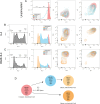Pattern recognition receptor ligand-induced differentiation of human transitional B cells
- PMID: 36040923
- PMCID: PMC9426890
- DOI: 10.1371/journal.pone.0273810
Pattern recognition receptor ligand-induced differentiation of human transitional B cells
Abstract
B cells represent a critical component of the adaptive immune response whose development and differentiation are determined by antigen-dependent and antigen-independent interactions. In this study, we explored the effects of IL-4 and pattern-recognition receptor (PRR) ligands on B cell development and differentiation by investigating their capacity to drive the in vitro maturation of human transitional B cells. In the presence of IL-4, ligands for TLR7/8, TLR9, and NOD1 were effective in driving the in vitro maturation of cord blood transitional B cells into mature, naïve B cells as measured by CD23 expression, ABCB1 transporter activation and upregulation of sIgM and sIgD. In addition, several stimulation conditions, including TLR9 ligand alone, favored an expansion of CD27+ IgM memory B cells. Transitional B cells stimulated with TLR7/8 ligand + IL-4 or TLR9 ligand, with or without IL-4, induced a significant subpopulation of CD23+CD27+ B cells expressing high levels of sIgM and sIgD, a minor B cell subpopulation found in human peripheral blood. These studies illustrate the heterogeneity of the B cell populations induced by cytokine and PRR ligand stimulation. A comparison of transitional and mature, naïve B cells transcriptomes to identify novel genes involved in B cell maturation revealed that mature, naïve B cells were less transcriptionally active than transitional B cells. Nevertheless, a subset of differentially expressed genes in mature, naïve B cells was identified including genes associated with the IL-4 signaling pathway, PI3K signaling in B lymphocytes, the NF-κB signaling pathway, and the TNFR superfamily. When transitional B cells were stimulated in vitro with IL-4 and PRR ligands, gene expression was found to be dependent on the nature of the stimulants, suggesting that exposure to these stimulants may alter the developmental fate of transitional B cells. The influence of IL-4 and PRR signaling on transitional B cell maturation illustrates the potential synergy that may be achieved when certain PRR ligands are incorporated as adjuvants in vaccine formulations and presented to developing B cells in the context of an inflammatory cytokine environment. These studies demonstrate the potential of the PRR ligands to drive transitional B cell differentiation in the periphery during infection or vaccination independently of antigen mediated BCR signaling.
Conflict of interest statement
The authors have declared that no competing interests exist.
Figures









Similar articles
-
Targeting CD22 with the monoclonal antibody epratuzumab modulates human B-cell maturation and cytokine production in response to Toll-like receptor 7 (TLR7) and B-cell receptor (BCR) signaling.Arthritis Res Ther. 2017 May 15;19(1):91. doi: 10.1186/s13075-017-1284-2. Arthritis Res Ther. 2017. PMID: 28506291 Free PMC article.
-
TLR7- and TLR9-responsive human B cells share phenotypic and genetic characteristics.J Immunol. 2015 Apr 1;194(7):3035-44. doi: 10.4049/jimmunol.1402690. Epub 2015 Mar 4. J Immunol. 2015. PMID: 25740945 Free PMC article.
-
Comparison of human B cell activation by TLR7 and TLR9 agonists.BMC Immunol. 2008 Jul 24;9:39. doi: 10.1186/1471-2172-9-39. BMC Immunol. 2008. PMID: 18652679 Free PMC article.
-
TLR1/2, TLR7, and TLR9 signals directly activate human peripheral blood naive and memory B cell subsets to produce cytokines, chemokines, and hematopoietic growth factors.J Clin Immunol. 2011 Feb;31(1):89-98. doi: 10.1007/s10875-010-9456-8. Epub 2010 Sep 7. J Clin Immunol. 2011. PMID: 20821041 Free PMC article.
-
[Multilevel maturation of Toll-like receptor 9].Postepy Hig Med Dosw (Online). 2013 Oct 30;67:1034-46. doi: 10.5604/17322693.1074013. Postepy Hig Med Dosw (Online). 2013. PMID: 24184955 Review. Polish.
Cited by
-
B cell dysfunction in thalamus and brainstem involvement and high lactate caused by novel mutation of EARS2 gene.Ital J Pediatr. 2025 May 19;51(1):143. doi: 10.1186/s13052-025-01999-5. Ital J Pediatr. 2025. PMID: 40389993 Free PMC article.
-
Enhancing vaccine effectiveness in the elderly to counter antibiotic resistance: The potential of adjuvants via pattern recognition receptors.Hum Vaccin Immunother. 2024 Dec 31;20(1):2317439. doi: 10.1080/21645515.2024.2317439. Epub 2024 Mar 4. Hum Vaccin Immunother. 2024. PMID: 39693178 Free PMC article. Review.
References
-
- Didierlaurent AM, Morel S, Lockman L, Giannini SL, Bisteau M, Carlsen H, et al.. AS04, an aluminum salt- and TLR4 agonist-based adjuvant system, induces a transient localized innate immune response leading to enhanced adaptive immunity. J Immunol. 2009;183(10):6186–97. Epub 2009/10/30. doi: 10.4049/jimmunol.0901474 . - DOI - PubMed
Publication types
MeSH terms
Substances
Grants and funding
LinkOut - more resources
Full Text Sources
Research Materials

